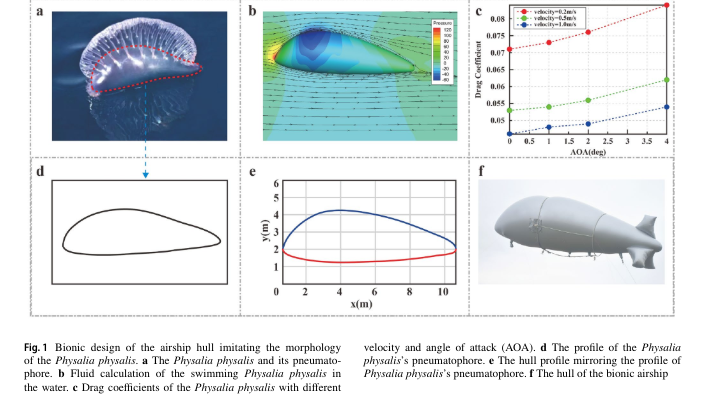Journal of Bionic Engineering (2024) 21:740–753 https://doi.org/10.1007/s42235-023-00470-7
Bionic Design and Experimental Validation of a Robotic Airship Inspired by the Physalia physalis
Yueneng Yang1 · Lili Chen2 · Zhiyang Liu1 · Shifeng Zhang1
1 College of Aerospace Science and Engineering, National University of Defense Technology, No. 109, Deya Road, KaiFu District, Changsha 410073, China 2 Aerospace Technology Institute, China Aerodynamics Research and Development Center, Mianyang 621000, China
AbstractThe robotic airship is one of the most unique and promising green aircraft, however, as a “lighter-than-air aircraft” and “thermal aircraft”, its long-endurance fight has great difculties in decreasing drag and controlling buoyancy and pressure under thermal efects. In this work, we reported a robotic airship inspired by the Physalia physalis, imitating its morphology, physiological structure, and biological behaviors. The hull is designed by imitating the morphology of the Physalia physalis, and the gasbags including a helium balloon, two ballonets, and a thermoregulation gasbag are designed by imitating the physiological structure and biological behaviors of the pneumatophore, bladder, and gland of the Physalia physalis, respectively. Experimental results show that the bionic airship has an increase of about 40% in lift-to-drag and decreases the pressure in helium balloon by 47.5% under thermal efects, and has better aerodynamic performances and thermoregulation performances than conventional airships.
Keywords Robotic airship · Bionic design · Aerodynamic performances · Thermoregulation · Physalia physalis

Copyright © 2024 International Society of Bionic Engineering All Rights Reserved
吉ICP备11002416号-1









